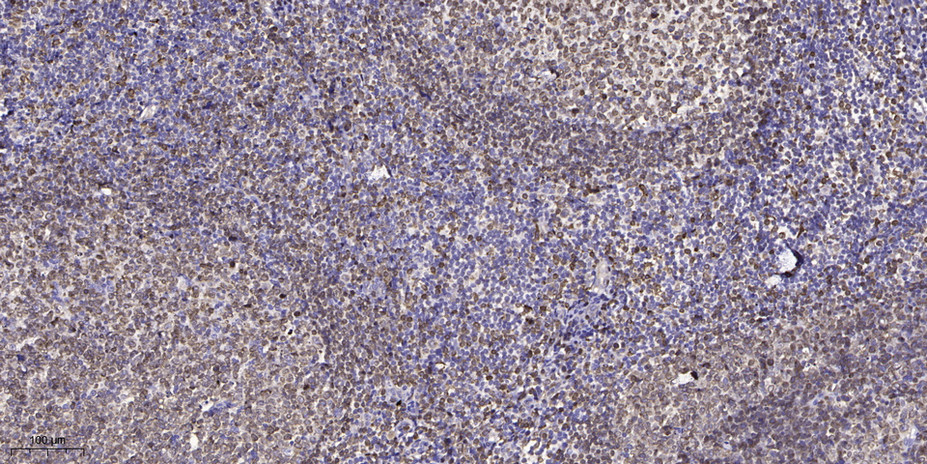Rho G Polyclonal Antibody
- Catalog No.:YT4080
- Applications:WB;IHC;IF;ELISA
- Reactivity:Human;Mouse;Rat
- Target:
- Rho G
- Fields:
- >>Bacterial invasion of epithelial cells;>>Salmonella infection;>>Yersinia infection
- Gene Name:
- RHOG
- Protein Name:
- Rho-related GTP-binding protein RhoG
- Human Gene Id:
- 391
- Human Swiss Prot No:
- P84095
- Mouse Gene Id:
- 56212
- Mouse Swiss Prot No:
- P84096
- Immunogen:
- The antiserum was produced against synthesized peptide derived from human RHOG. AA range:97-146
- Specificity:
- Rho G Polyclonal Antibody detects endogenous levels of Rho G protein.
- Formulation:
- Liquid in PBS containing 50% glycerol, 0.5% BSA and 0.02% sodium azide.
- Source:
- Polyclonal, Rabbit,IgG
- Dilution:
- WB 1:500 - 1:2000. IHC 1:100 - 1:300. ELISA: 1:40000.. IF 1:50-200
- Purification:
- The antibody was affinity-purified from rabbit antiserum by affinity-chromatography using epitope-specific immunogen.
- Concentration:
- 1 mg/ml
- Storage Stability:
- -15°C to -25°C/1 year(Do not lower than -25°C)
- Other Name:
- RHOG;ARHG;Rho-related GTP-binding protein RhoG
- Observed Band(KD):
- 23kD
- Background:
- This gene encodes a member of the Rho family of small GTPases, which cycle between inactive GDP-bound and active GTP-bound states and function as molecular switches in signal transduction cascades. Rho proteins promote reorganization of the actin cytoskeleton and regulate cell shape, attachment, and motility. The encoded protein facilitates translocation of a functional guanine nucleotide exchange factor (GEF) complex from the cytoplasm to the plasma membrane where ras-related C3 botulinum toxin substrate 1 is activated to promote lamellipodium formation and cell migration. Two related pseudogene have been identified on chromosomes 20 and X. [provided by RefSeq, Aug 2011],
- Function:
- function:Required for the formation of membrane ruffles during macropinocytosis. Required for the formation of cup-like structures during trans-endothelial migration of leukocytes. In case of Salmonella enterica infection, activated by SopB and SGEF, which induces cytoskeleton rearrangements and promotes bacterial entry.,similarity:Belongs to the small GTPase superfamily. Rho family.,subunit:Interacts with SGEF.,
- Subcellular Location:
- Cell membrane ; Lipid-anchor ; Cytoplasmic side .
- Expression:
- Brain,PCR rescued clones,
- June 19-2018
- WESTERN IMMUNOBLOTTING PROTOCOL
- June 19-2018
- IMMUNOHISTOCHEMISTRY-PARAFFIN PROTOCOL
- June 19-2018
- IMMUNOFLUORESCENCE PROTOCOL
- September 08-2020
- FLOW-CYTOMEYRT-PROTOCOL
- May 20-2022
- Cell-Based ELISA│解您多样本WB检测之困扰
- July 13-2018
- CELL-BASED-ELISA-PROTOCOL-FOR-ACETYL-PROTEIN
- July 13-2018
- CELL-BASED-ELISA-PROTOCOL-FOR-PHOSPHO-PROTEIN
- July 13-2018
- Antibody-FAQs
- Products Images

- Western blot analysis of lysates from Jurkat cells, using RHOG Antibody. The lane on the right is blocked with the synthesized peptide.

- Immunohistochemical analysis of paraffin-embedded human tonsil. 1, Antibody was diluted at 1:200(4° overnight). 2, Tris-EDTA,pH9.0 was used for antigen retrieval. 3,Secondary antibody was diluted at 1:200(room temperature, 45min).



